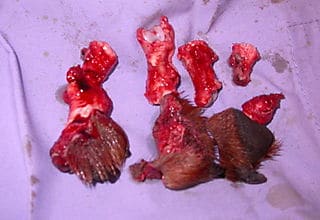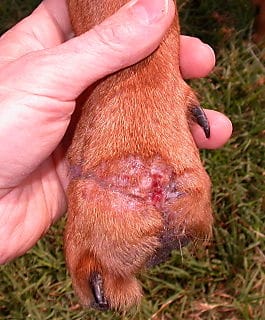Warning: We have a happy ending, but there are some gross pictures.
Crushing injuries are among my least favorite. They not only do a lot of damage, but it is difficult to determine the extent of the damage when you first examine them. Sometimes tissue looks okay, but has had its circulation irreparably damaged. You work diligently to reconstruct the injury and three or four days later everything turns black and rots off. Since you can’t tell for sure whether something will survive, you salvage as much as you can and hope for the best.
 This is Duke the Bloodhound. He’s only six months old and already weighs 62 pounds. I estimate that his adult weight will be close to 100 pounds, or about 25 pounds per paw. Actually, dogs tend to carry more weight on their front legs in motion, so maybe 30 pounds per front paw and 20 pounds per rear paw. That would make it bad to have only one front paw; it would have to carry quite a bit more weight than it is designed to.
This is Duke the Bloodhound. He’s only six months old and already weighs 62 pounds. I estimate that his adult weight will be close to 100 pounds, or about 25 pounds per paw. Actually, dogs tend to carry more weight on their front legs in motion, so maybe 30 pounds per front paw and 20 pounds per rear paw. That would make it bad to have only one front paw; it would have to carry quite a bit more weight than it is designed to.
Duke ran in front of his owner’s truck in the driveway. His owner slammed on the brakes to keep from running over him, but actually stopped the truck on top of his right front paw. Being between a ton-truck and an asphalt drive is very similar to being between a rock and a hard place. Plus, there was a little skidding in the process.
 When Duke got free, he ran under some bushes, filling his mangled paw with dirt. This is what it looked like when I saw it soon afterwards.
When Duke got free, he ran under some bushes, filling his mangled paw with dirt. This is what it looked like when I saw it soon afterwards.
 This is what it looked like when I began to clean it (and yes, he is anesthetized by now).
This is what it looked like when I began to clean it (and yes, he is anesthetized by now).
 This is how much I knew was crushed beyond repair and had to just trim off and chuck into the trash (I mean the biohazard container).
This is how much I knew was crushed beyond repair and had to just trim off and chuck into the trash (I mean the biohazard container).
 This is what it looked like after the initial reconstruction. All he has left is his little toe and the big metacarpal pad, but it looks pretty slick. I was hoping that big pad would survive. While the foot would be far from normal, if he had that much left, I felt it would be enough weight-bearing surface to give his good leg a rest. We are using a LOT of pain medication now, lots of antibiotics, lots of bandage material.
This is what it looked like after the initial reconstruction. All he has left is his little toe and the big metacarpal pad, but it looks pretty slick. I was hoping that big pad would survive. While the foot would be far from normal, if he had that much left, I felt it would be enough weight-bearing surface to give his good leg a rest. We are using a LOT of pain medication now, lots of antibiotics, lots of bandage material.
 This is Callie. We don’t know what happened to her front toes, as she was adopted from a shelter. Maybe it was a de-claw gone wrong, but we really don’t know. She gets along fine, except for having to stop every now and then – she’ll sit up on her haunches, give those front paws a little shake and then continue about her business.
This is Callie. We don’t know what happened to her front toes, as she was adopted from a shelter. Maybe it was a de-claw gone wrong, but we really don’t know. She gets along fine, except for having to stop every now and then – she’ll sit up on her haunches, give those front paws a little shake and then continue about her business.
 This is all she has for front feet, and she’s making it pretty fair (although on light duty, admittedly). Callie’s toe-less feet were the reason I opted to try and save some of Duke’s foot, instead of just amputating his leg.
This is all she has for front feet, and she’s making it pretty fair (although on light duty, admittedly). Callie’s toe-less feet were the reason I opted to try and save some of Duke’s foot, instead of just amputating his leg.
 So here we are with Duke again on day 6, when the dead tissue comes apart. It’s not looking so good. Now comes about 10 days of bandage changes and cleaning and removing dead tissue until we finally get down to nothing but live, healthy tissue.
So here we are with Duke again on day 6, when the dead tissue comes apart. It’s not looking so good. Now comes about 10 days of bandage changes and cleaning and removing dead tissue until we finally get down to nothing but live, healthy tissue.
We performed a second reconstruction, on day 15 after the injury. (sorry, lost the picture) Now we have more bandage changes for the next two weeks, plus a few more days of topical therapy in the hospital.
 Here we have the almost finished product. Just a little raw spot in the middle, and it’s getting smaller every day. He walks on this foot, even runs on it some. It only took five weeks in the hospital, a gazillion bandage changes, and a whole lot more money than it would have cost to just amputate that leg. I think it’s going to be worth it, though, to have four feet for the rest of his life (even 3 and ¾ feet).
Here we have the almost finished product. Just a little raw spot in the middle, and it’s getting smaller every day. He walks on this foot, even runs on it some. It only took five weeks in the hospital, a gazillion bandage changes, and a whole lot more money than it would have cost to just amputate that leg. I think it’s going to be worth it, though, to have four feet for the rest of his life (even 3 and ¾ feet).


Great to see Callie, she looks good!
Duke is such a handsome hunk…I hope his paw works out well for enough support.
Hello,
There is a popular superstition that maggots will only eat dead tissue. This is not correct. Every summer we see patients with moist, matted hair. Flies lay their eggs in these moist areas, and even with no primary wound, the maggots will burrow in and create a crater of a wound. These patients become septic and die if not caught in time.
There may be a place for maggots in debridement, but I don’t have the expertise to use them successfully.
I have a bloodhound, 3 yrs. old. The large pad on her back and front paw seemed to have split their outer covering from back to front. There is no obvious puncture injury or bleeding. It seems mildly painful. Has anyone heard of this happening to other dogs? If so, what causes it and what can I do???
Hello, Kimberly,
The most common cause of split pads is trauma, i.e. stepping on something sharp. It is also possible for weird things like auto-immune disease (where the body’s defense system goes haywire and attacks self) to damage the footpads. Sometimes a biopsy of the affected area is necessary in order to make a diagnosis.
Footpad splits are best treated with bandaging. Otherwise, every time the dog stands down on the pad, it spreads the wound open.
You need to take your dog to his veterinarian for evaluation.
Thanks for reading and writing.
My dog got it’s foot run over by a school bus. The Vet said the toes don’t feel broke and she is walking in it. However, the big pad is swollen and hasn’t gone down at all in two weeks. Should I take her to a different Vet?
Hello, Susan,
You should let your doctor know that things haven’t gotten well as expected. We make a judgment based on how things looked at the time. If t hings don’t go according to plan, we re-evaluate. Without any feedback, your doctor thinks everything is okay.
I’d say it’s time to get an X-ray.